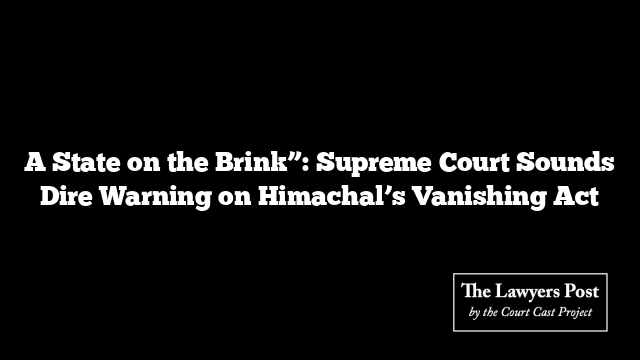The Supreme Court didn’t mince words. Himachal Pradesh, the land of snow-capped serenity and pine-lined dreams, could — quite literally — disappear off the country’s map if humanity’s appetite for construction and profit continues unchecked. In a scorching rebuke, the Court warned that the ecological devastation unfolding in the Himalayan State has reached a point where the entire region is on the verge of collapse.
The bench of Justices JB Pardiwala and R Mahadevan, delivering what can only be described as a judicial wake-up call, not only upheld a notification that declared Shri Tara Mata Hill a protected green zone — thereby quashing a plea by a private hotel company — but went a step further: it launched a suo motu public interest litigation on the broader issue of environmental ruin in Himachal.
“If this continues,” the Court warned, “the day is not far when the entire State of Himachal Pradesh may vanish in thin air from the map of the country.”
Behind the poetic imagery lies a grim reality. Roads slicing through mountains, hydroelectric dams hammering fragile river basins, forests reduced to stumps, and towns swelling beyond reason — these, the Court said, are not nature’s fury but humanity’s folly. The judgment made it clear: blaming nature for landslides and collapsing roads is misdirection. The real culprits are bulldozers, excavators, and unchecked ambition.
The bench cited expert findings implicating major infrastructure projects like Bhakra and Nathpa Jhakri for altering the very geology of the region. Rivers once mighty — especially the Sutlej — are now trickling streams, robbed of their flow by project operators who flout minimum water release norms. “The mighty trans-Himalayan river Sutlej stands reduced to a rivulet,” the Court lamented.
And it’s not just what’s being built — but what’s being neglected. Melting glaciers, erratic rainfall, collapsing slopes, vanishing biodiversity, and the unplanned tourism explosion are carving deep wounds into Himachal’s already fragile ecosystem. The booming tourist trade — religious and eco alike — has brought with it a toxic trail: trash-choked hill towns, illegal construction in Rohtang and Kullu, and deforestation driven by greed and apathy.
The Court sharply criticised the State for failing to regulate solid waste, curb illegal tree-felling, or enforce environmental laws in trekking routes and forests. What emerged was a portrait of a State either unwilling or unable to defend itself from the consequences of its own short-term planning.
“Revenue cannot be earned at the cost of environment and ecology,” the Court declared, issuing a blunt reminder to the Himachal Pradesh government and the Centre alike.
Faced with the Advocate General’s admission that the State had not adequately responded to the Court’s earlier observations, the bench ordered a full status report within four weeks. The matter, now treated as a public interest litigation on environmental degradation in Himachal, will be heard again on August 25.
The judicial gavel has fallen. Whether it echoes through the bureaucracy, or is muffled by inertia and excuses, will determine whether Himachal’s future remains on the map — or in memory.





